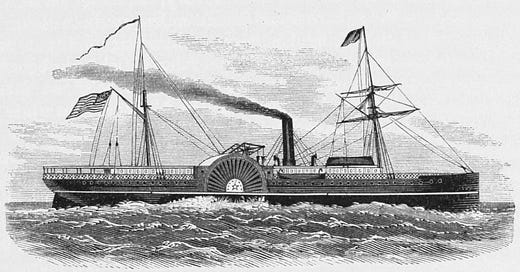TDIH: The Star of the West
“Is this the beginning of the Civil War of which we have heard so much . . . ?”
On this day in 1861, shots are fired at a merchant ship acting on behalf of the federal government in Charleston Bay. “Good God! Is this true?” one witness wrote. “Is this the beginning of the Civil War of which we have heard so much . . . ?”
It wasn’t. But it sure was close!
Matters in America were then very tense. Abraham Lincoln had just been elected, but he hadn’t been sworn in yet. His election prompted South Carolina to secede from the Union. The state didn’t view itself as a rebel state. It was a sovereign state that had voluntarily joined the Union. Now it thought that it could simply retract that agreement.
At least one immediate problem presented itself. What was to be done about federal garrisons within South Carolina? Obviously, the federal government wanted to keep those forts. Just as obviously, the sovereign state of South Carolina did not want an outside authority to have military strongholds within its borders.
It didn’t take long for matters to come to a head.
When South Carolina seceded, the main federal garrison was Fort Moultrie, which was weakly staffed with less than 100 soldiers. The commanding officer, Major Robert Anderson, decided to move his men to Fort Sumter. That fort was then under construction, but it was still bigger and stronger.
South Carolinians were outraged! They’d understood from President James Buchanan that a status quo would be maintained until an agreement could be worked out. Thus, Anderson’s move was viewed as a threat.
If only that had been the end of it. But it wasn’t.
The U.S. government still wanted to restock and reinforce Fort Sumter. It decided to charter a merchant ship, the Star of the West, for this purpose. It was hoped that a merchant ship would not be viewed as a threat, whereas a warship certainly would be. Two hundred soldiers were hidden aboard the steamer.
Um, so much for maintaining a status quo?
The steamer approached the harbor early on January 9. It was soon noticed by Citadel cadets on Morris Island. A warning shot was fired across the ship’s bow, but the Star of the West still didn’t stop. Instead, it raised a large U.S. flag.
The raised flag was viewed as a sign of defiance. The cadets opened fire.
“We continued on under the fire of the battery for over ten minutes,” the captain of the Star of the West later wrote, “several of the shots going clear over us. . . . At the same time there was a movement of two steamers from near Fort Moultrie, one of them towing a schooner (I presume an armed schooner), with the intention of cutting us off. Our position now became rather critical . . . . having no cannon to defend ourselves from the attack of the vessels, we concluded that, to avoid certain capture or destruction, we would endeavor to get to sea.”
The Star of the West escaped, but the impasse over Fort Sumter would continue for several more months.
That’s not the end of the story, of course. More shots would be fired at Fort Sumter in April 1861, officially launching the Civil War.
Naturally, that is a story for another day.
Sources can always be found on my website, here.





This lesson is long overdue in my knowledge of the Civil War.
The particulars of the war's beginnings are seldom mentioned anywhere. Thanks, Tara, for your unwavering pursuit of clear truth.